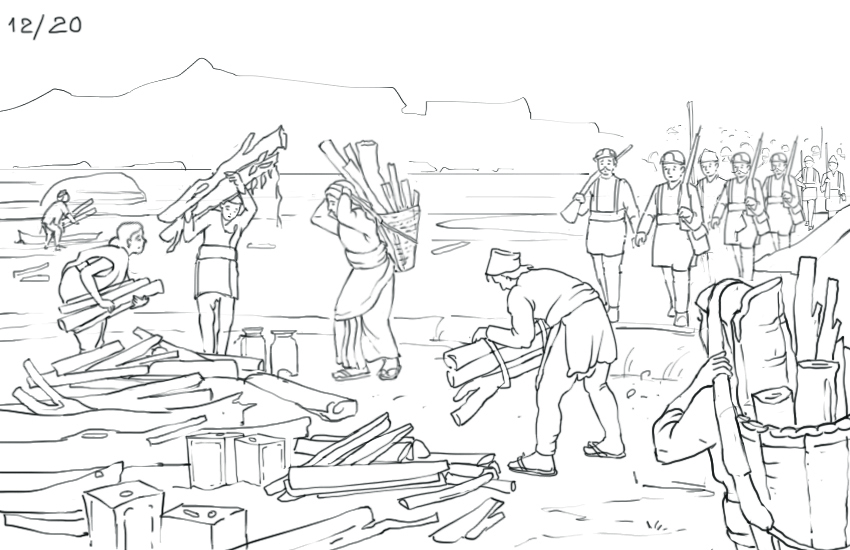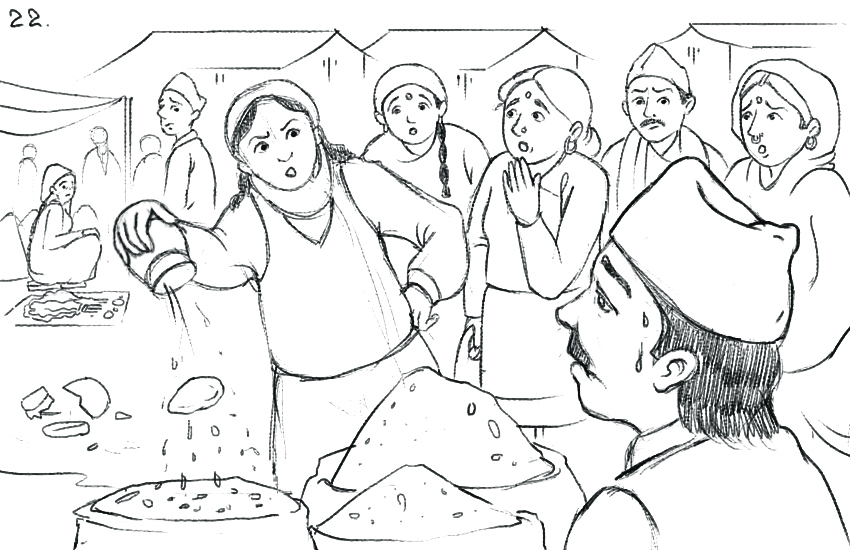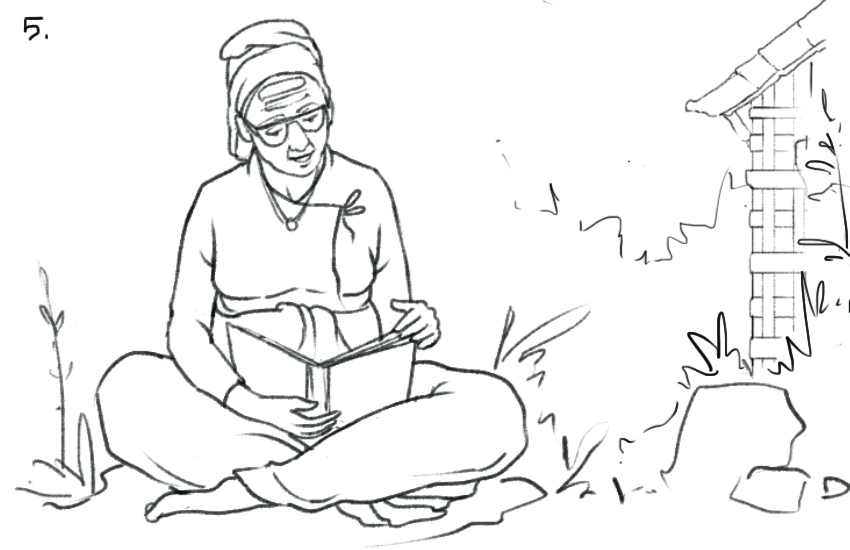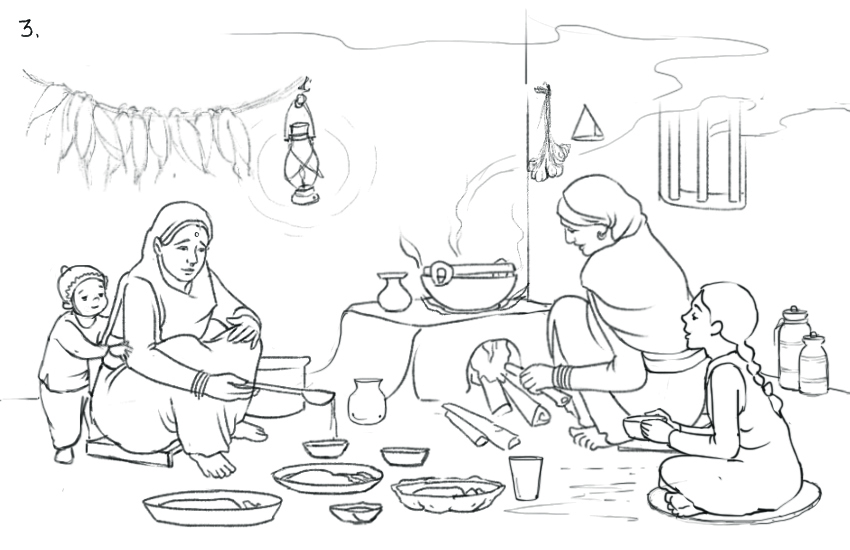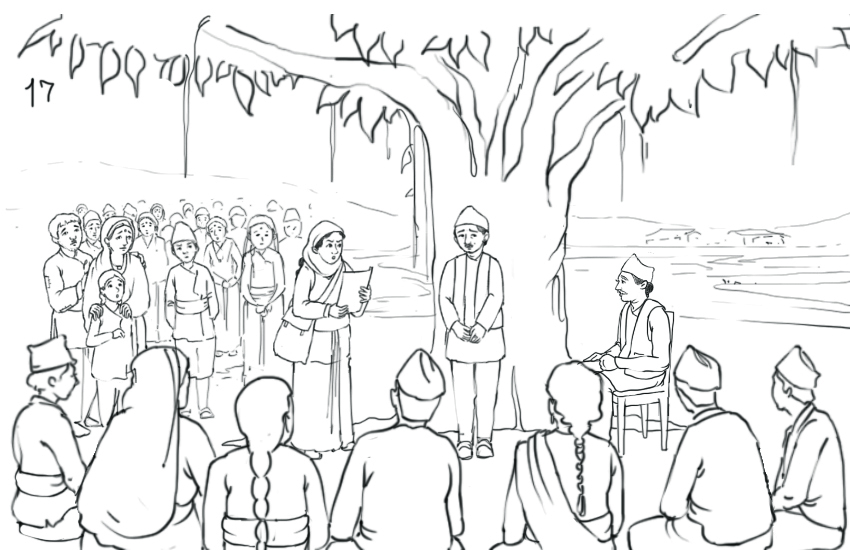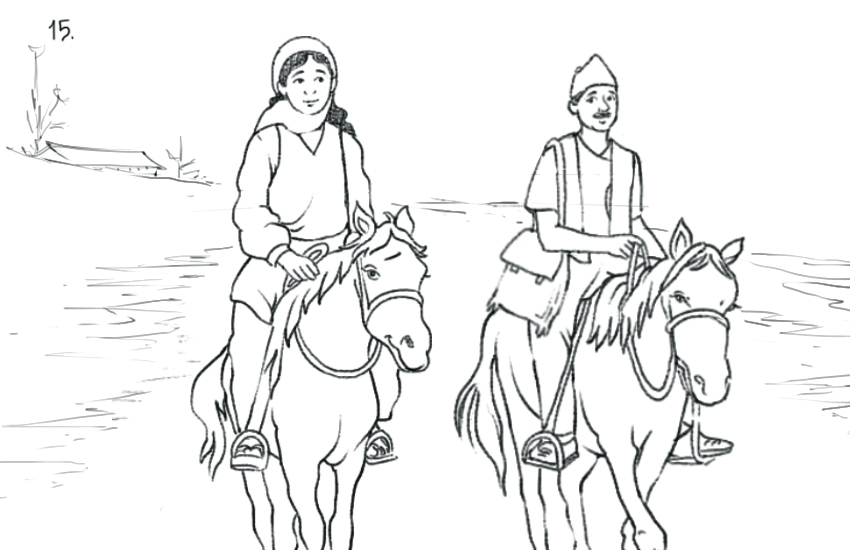JUSTICE STORIES: Meet Nepal’s Frontier Women, 2023
Illustrations by Anamika Gautam

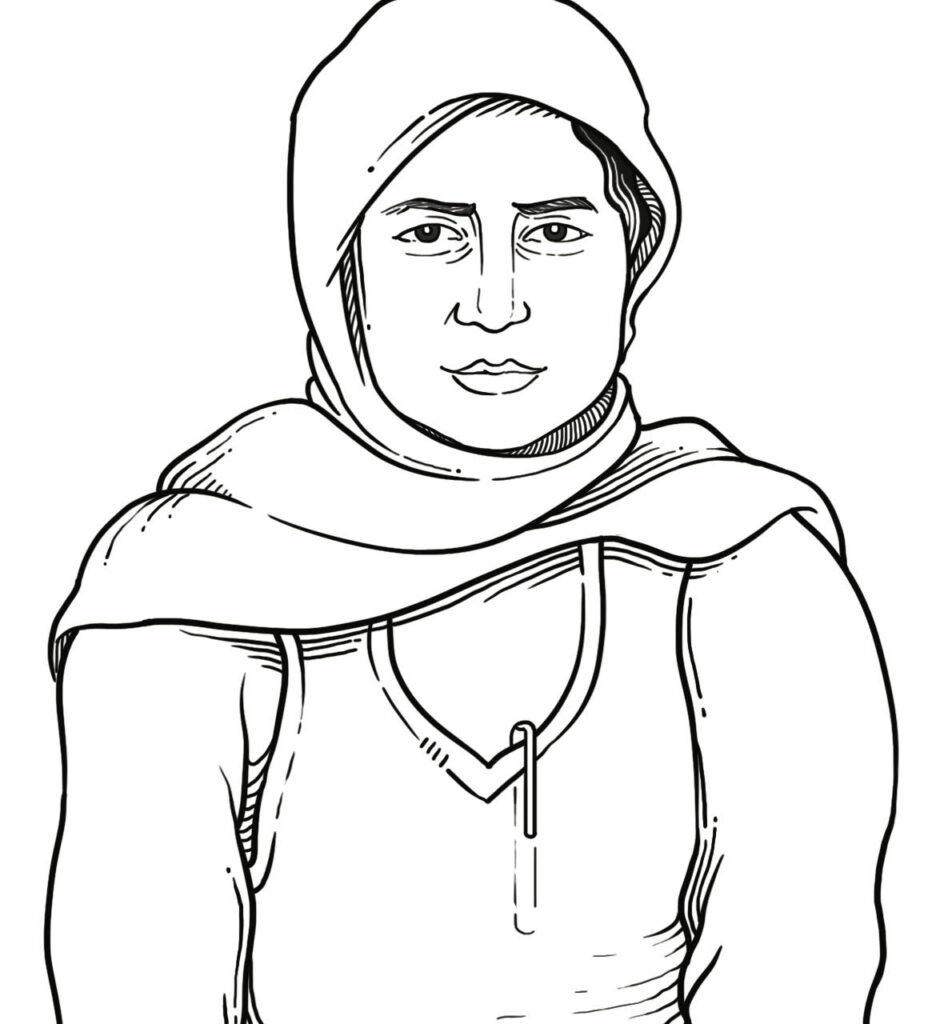
Fighting for justice is never easy. But long, long ago, two women, both from villages deep in the hills of Nepal, dared to call for fairness and equality, and an end to corruption. They struggled for their own rights; then they fought to win justice for others. They needed courage and a steadfast belief that change was possible.
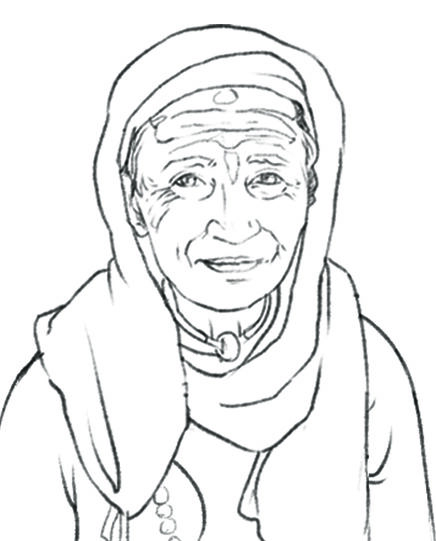
Records of their brave actions almost disappeared. But some traces remained. Yogmaya’s and Durga Devi’s excavated little-known history is hereby presented to young readers. They will learn how these Nepali women were part of a worldwide struggle of people seeking justice at the same time as them.
Beautifully illustrated, the book is written in English, for children aged 10-15. Available in Nepal from the publisher, Sangri-La Books. For availability in the U.S. and elsewhere, contact the author directly.
“Stories passed down to us through oral traditions find a new medium through this book by Dr. Barbara Nimri Aziz. The author has preserved the essence of storytelling, seamlessly weaving the lives of two remarkable Nepali women into a pattern that includes the whole world. These women will inspire not only girls in Nepal but anyone who believes in justice.”
Manaslu Gurung
“The long hidden, genuine truth of the struggle for justice waged by two brave ladies, Nepal’s Yogmaya and Durga Devi, will now be exposed internationally, even to the young generation, with this grand effort by a capable, experienced researcher, Dr. Barbara Nimri Aziz.”
Sukanya Waiba
“This is a captivating book that weaves together the lives of two ferocious and understudied Nepali leaders. By making accessible their legal, spiritual and cultural activism, Barbara Nimri Aziz is a cheerleader for bravery in young women and girls.”
Sabrina Singh
Yogmaya & Durga Devi: Rebel Women of Nepal, 2020

Is it possible that a century ago two women, both champions of justice, emerged from little-known villages in East Nepal to offer solutions to their nation’s social and political ills? In this volume B. Nimri Aziz continues to pursue the legacy of these historical figures whose achievements she first documented starting in 1980.
Heir to A Silent Song brought Yogmaya Neupane to public attention. Here the author moves from historical disclosure to question Yogmaya’s relevance in contemporary Nepal, while also turning the spotlight on Durga Devi Ghimire, Yogmaya’s compatriot. She asks: what do these women, with their contrasting strategies and visions, offer modern Nepal?
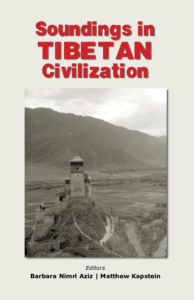
Soundings in Tibetan Civilization, 1984, 2009
Co-editors: BN Aziz, M. Kapstein
Only in the 1980s, did Tibetan Studies expand to include a wide range of issues and disciplines. This volume is representative of that emerging and healthy diversity. This collection is a reflection of this new development, an enriching dialogue among scholars in linguistics, philosophy, history, sociology and anthropology, Buddhism, politics, geography, phonology, musicology, iconography and art, poetry, architecture, liturgical studies, museum management, hagiography and biography.
More than a quarter of authors represented here were born in Tibet or nearby Himalayan regions. Their inclusion, along with Chinese presenters, is another testimony of the widening character of the international community of scholars and how much they offer one another.
These articles were first presented by thirty-four Tibet and Himalayan scholars at the 2nd International Conference of Tibetan Studies (following the 1980 Oxford Conference of Young Tibetologists), convened by BN Aziz in 1982 at Columbia University, edited to incorporate discussions emerging from the seminar proceedings. First published in 1985 by Manohar Publications, New Delhi, it was reprinted and reissued (unchanged) in 2009 by Vajra Books, Kathmandu.
Short Features for Radio: A Manual for Broadcast Journalists, 2011
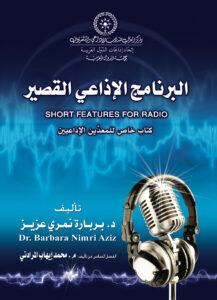
The Arab nations, led by Egypt, and globally renowned through the excellence of Al- Jazeera TV Network, have an established tradition in journalism.
A basic skill media directors seek to incorporate into contemporary broadcasting is brevity. Thus B.N. Aziz 5-week hands-on courses– “The Art of Interviewing”, and “Short Features for Radio”– for radio and TV professionals at the Pan-Arab Media Centre in Damascus.
Aziz was invited to adapt the “short features” course into a ‘handbook’ for future use at the centre and for wider distribution. Released in 2011, its chapters include: The Qualities and Potential of Shorts, What’s The Story, Sound Gathering, Composing the Story, Editing, and Archiving.
Published by Arab States Media Centre for Radio and Television, Damascus, Syria. (in Arabic with an accompanying English CD digital translation.)
Tibetan Frontier Families: Three Generations from Dingri, 1978, 2011
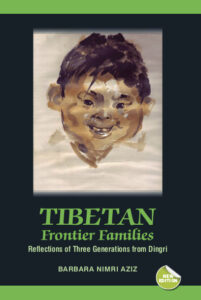
Available through Garuda Books
Still referenced 40 years on by Tibet scholars and anthropologists, updated with new illustrations, the author’s exhaustive interview-based portrait composed among refugees in Nepal in 1970 is augmented with new fieldwork inside Tibet to offer an unsurpassed socio-historical chronicle of three generations of Dingri people. In Tibetan Frontier Families, we have a classic Tibetan ethnography.
An extensive new preface contains rich details from the author’s 1985-88 research expeditions into Dingri, a community of about a hundred villages in southwest Tibet on the route between Nepal and Lhasa. The windswept valleys of this stretch of the Tibetan plateau survive with runoff from nearby Everest glaciers to its south, its population not only surviving under Chinese rule but able to retain much of their past lifestyle in an unwavering harsh terrain.
A chart of Dingri villages, constructed for the researcher by a Dingri refugee became Aziz’ blueprint for oral reconstructions of their culture, then served a map for her anthropological forays within Tibet itself.
Unparalleled personal family portraits grow into this ethnography. They reveal the specific and the general character of Tibet society- a complex household structure, the interface of religion and social life, its foraging and herding economy as lived in Dingri’s austere alpine ecology.
We learn what it means to be a nun or a monk in a rural atmosphere as opposed to grand monastic edifices. We are introduced to marriage and family life, pottery and communal plowing, to a diversity of religious work and spiritual leadership. Thereby the rhythm of an extant although wounded civilization emerges.
Changes imposed by Chinese authorities after 1959 are extensive but not as invasive as was thought, a tribute to Dingri’s resourcefulness.
This edition includes a collection of intimate photos by the author, taken during her excursions across what she calls, the “Sea of Dingri”.
Swimming up the Tigris: Real Life Encounters with Iraq, 2007

As Americans went about their daily lives through the 1990s, few imagined what Iraqi men and women faced under the brutal sanctions declared by the U.N. and strictly enforced by the United States. It lasted 13 years.
Barbara Nimri Aziz, a frequent visitor to Iraq through that period, saw first-hand what life was like for Iraqis completely cut off and shunned by the world.
Swimming up The Tigris reveals the power of Aziz’s combined skills in journalism and anthropology. Through her first-hand accounts, ordinary Iraqis speak directly to us. We learn of the breakdown of Iraq’s fine administrative and educational institutions, of needless deaths resulting from the embargo-ravaged once exemplary healthcare system, of the brain drain of its highly skilled professional class. We hear of deprivations, aerial bombardments, and local efforts to fight the wide-ranging embargo with no outside help whatsoever.
Drawing on intimate sources inside Iraq, the author reveals disparities between news reports of unfolding events and what Iraqi men and women were actually experiencing in the months preceding the U.S.-led invasion in 2003.
By revisiting this critical period, Aziz sheds light illegal, cruel tactics used by the United States to destroy Iraq through sanctions well before the WMD ruse for all out occupation. This book offers an essential context for others to appreciate early opposition to U.S. policies, to understand embargo as the ‘real’ weapon of mass destruction, the rise of ISIS, and the disastrous American occupation of the nation.
Heir to a Silent Song: Two Rebel Women of Nepal, 2001

When fat bellies rupture
spilling bribes you’ve hoarded;
the riches inside become your poison;
Meanwhile, savour what’s stuffed there.
Indictments like this quatrain (translated from Nepali original) by the 20th century rebel Yogmaya Neupane, constitute the core of her political message and a daring campaign against corruption and discrimination a hundred years ago. Shakti Yogmaya’s story, along with the chronicle of Durga Devi, a second fighter for social justice, is revealed in this book.
Starting in 1980, and pursued up to 1985, anthropologist B.N. Aziz traces the concealed history of two extraordinary Nepali women, Yogmaya and Durga Devi, both from rural East Nepal,.
Biographical sketches of those hitherto unrecorded civil rights advocates were first presented at academic conferences in 1990 and 1993. Eventually they formed the scaffold on which Aziz built a new socio-political portrait of women in Nepal. This book incorporates the author’s preceding decade of observations of rural life across the country (composed in three semi-fictional portraits), her collaboration with the renowned Marxist poet and dissident, Parijat, and her examination of the political ills of Nepal under Rana rule that continued into the Shah monarchy.
Heir to a Silent Song refers to suppressed events revealed to the author by a community of elderly women ascetics, sanyasi– erstwhile militant followers of Yogmaya who’d sought reforms and justice 60-70 years earlier. Survivors of a government crackdown in 1940, they worked with the author to provide hitherto unrecorded details, trusting that their long-held secret would be made public.
Publication of this history needed another decade and the arrival of freedom of speech and the lifting of the ban on events surrounding Yogmaya’s death before others would pursue and discuss the story.
An added contribution of this book is the inclusion of a Nepali text, the collected utterances (sarvatha yogvani) of the Yogi rebel.
Published by CNAS (Centre for Nepal and Asian Studies), Tribhuvan University, Kathmandu, 2001.
The Traditions of Pha Dampa Sangyas: A Treasurd Collection of His Teachings, 1979
Five volume Tibetan text, with intro by BN Aziz
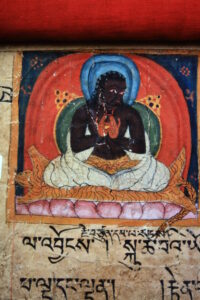
Among treasured documents carried form Tibet with refugees was a three volume illustrated, illuminated manuscript record of the teachings of Pha Dampa Sangyas, the 12 C. Black Yogi, originator of Zhi-je philosophy and practice, arrived in Tibet from India. Though famed, his center was a modest retreat at Dingri Lankgor where the manuscript was housed.
Aziz’s research into Dingri history and the story of the Langkor Nangten (relics), an orally transmitted account of PhaDampa’s history, led to a more extensive project culminating in the reproduction of this treasured text. Anthropologist Aziz, fluent in Tibetan, had several years of association with Thupten Choeling Monastery (and nunnery) in Solu-Khumbu, Nepal. Trusted by Trulshik Rinpoche the revered abbot, he invited her to photograph (on 35 mm film stock) the complete manuscript extending to hundreds of pages, an exercise undertaken in the monastery courtyard over the course of many weeks and under his attentive care.
The eminent Tibetologist E. Gene Smith confirmed the value of the text and worked with Aziz to have her photographic document copied, edited, then printed in Bhutan. Smith invited Aziz to prepare a short English introduction for inclusion in volume one of the five volumes in the traditional Tibetan format. The original manuscript is safely hidden, while many reproductions of the original photographed copy are widely distributed, translated, and made available to scholars and Buddhist students. Among Aziz’ original photographs are close-ups of illustrations within the text, which we make available to readers.

